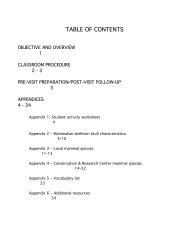facilities renewal master plan - National Zoo - Smithsonian Institution
facilities renewal master plan - National Zoo - Smithsonian Institution
facilities renewal master plan - National Zoo - Smithsonian Institution
You also want an ePaper? Increase the reach of your titles
YUMPU automatically turns print PDFs into web optimized ePapers that Google loves.
FACILITIES MASTER PLAN ENVIRONMENTAL ASSESSMENT<br />
Architectural sites were appraised for their historic value and the need to preserve<br />
them; and<br />
Olmsted’s innovative blueprint was reevaluated and utilized in the redesigned<br />
<strong>plan</strong> for Olmsted Walk, a tribute to the <strong>National</strong> <strong>Zoo</strong>’s original designer.<br />
Upgrades to the <strong>National</strong> <strong>Zoo</strong>’s Olmsted Walk and entry points at Rock Creek Park and<br />
Connecticut Avenue were constructed in 1984. These upgrades and redesigns maintained<br />
and enhanced the original Olmsted concept of curvilinear design. Beaver Valley was<br />
developed to simulate the natural flow of a mountain stream into the ocean. As visitors<br />
wound their way through exhibits, they were prompted to experience animals in<br />
environments that more closely mirrored their natural habitats, and were educated about<br />
the links between differing natural environments (Cooper-Lecky Architects, et al., 1986).<br />
1961 Master Plan<br />
Through the 1950s and into the early 1960s, the <strong>National</strong> <strong>Zoo</strong> had plummeted into<br />
disrepair, primarily due to lack of funds. This was largely a response to our country’s<br />
involvement in World War II and then the Korean War. There was a tragic accident in<br />
1958 involving a 2½-year old girl being killed by a lion at the Lion House. This forced<br />
the <strong>National</strong> <strong>Zoo</strong> to rapidly reevaluate its safety and policies. The product of that<br />
examination was the development of the 1961 Master Plan. Animal health and public<br />
safety became the focal points of this <strong>plan</strong>ned modernization. The prior establishment of<br />
FONZ and the following decision by Congress to fund the <strong>National</strong> <strong>Zoo</strong> entirely through<br />
the SI provided much needed financial security. The <strong>National</strong> <strong>Zoo</strong> began to modernize<br />
its on-site <strong>facilities</strong> as well as develop education, volunteer, and research programs to<br />
help promote conservation throughout the 1960s. The principles behind this <strong>plan</strong> paved<br />
way for new projects such as:<br />
The Conservation and Research Center – est. 1975, an off-site conservation<br />
center;<br />
New on-site hospital and research <strong>facilities</strong>, with an updated and modern<br />
administration building; and<br />
Animal housing designed to resemble caves or grottos, disguising that they are<br />
buildings, (Farrell, 2004).<br />
The Olmsted Concept<br />
The <strong>National</strong> <strong>Zoo</strong>, established in 1889, was built to house a small collection of animals<br />
donated to SI. SI commissioned the firm of renowned landscape architect Frederick Law<br />
Olmsted to design the <strong>National</strong> <strong>Zoo</strong>. Olmsted’s design <strong>plan</strong>ned a naturally scenic park<br />
that worked with the steep and winding topography of Rock Creek Valley. He stayed<br />
away from the linear standard of his period to avoid sharp edges and provide for focal<br />
points and natural vistas along pathways, showcasing the exhibits (Cooper-Lecky<br />
Architects, et al., 1986).<br />
Although the <strong>National</strong> <strong>Zoo</strong> was initially designed with a very naturalist ideal, it didn’t<br />
take long before the park-like setting gave way to more menagerie-type displays. The<br />
method coincided with the exhibiting standards of the early part of the 20 th century, one<br />
SMITHSONIAN INSTITUTION – NATIONAL ZOOLOGICAL PARK 8 | P a g e

















